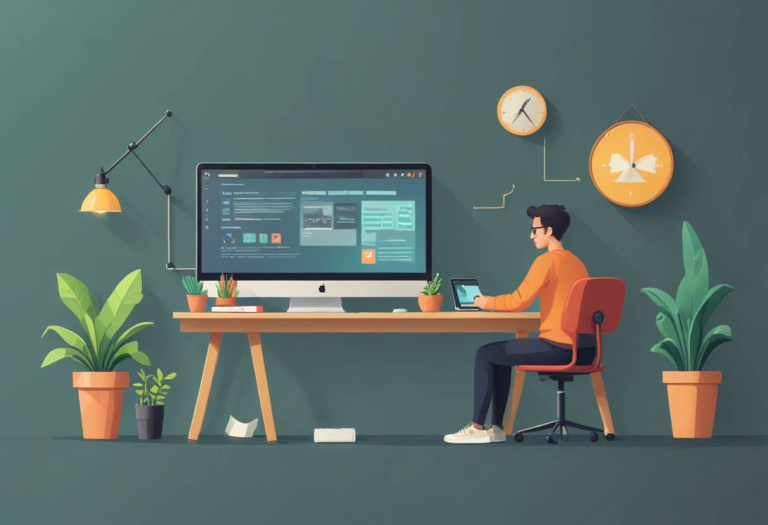As businesses step into 2025, staying competitive requires understanding and actively adopting the latest full-stack development trends. These trends are shaping the future of software development, driving technological advancements, enhancing customer experiences, and optimizing business processes across industries. In this digital sphere, companies that fail to keep up risk falling behind in terms of innovation, efficiency, and market relevance.
According to Google Trends data from the past five years, Full Stack Development has witnessed a steady upward trajectory, indicating its growing significance. This surge in demand is fueled by businesses striving for scalable, high-performance, and cost-effective digital solutions. With the increasing adoption of cloud computing, artificial intelligence, and automation, full-stack developers are expected to be more versatile than ever, seamlessly integrating both front-end and back-end technologies to create dynamic and responsive applications.
As the digital economy expands, businesses are investing in modern development frameworks, microservices architecture, and DevOps practices to accelerate product development and deployment. The emphasis on seamless user experiences, data security, and scalability means that full-stack development is no longer just a technical necessity—it has become a strategic advantage.
Here a look at the key trends shaping the future of full-stack development:
1. Artificial Intelligence (AI)
According to Gartner, by 2025, 80% of enterprises will utilise AI-driven applications to enhance operational efficiency and customer engagement. AI is revolutionizing full-stack development by automating workflows, delivering personalized services, and improving decision-making. AI-powered solutions, such as chatbots, reduce response times for customer inquiries, while recommendation engines boost sales by offering tailored product suggestions. Predictive analytics further help businesses anticipate customer needs and market trends.
Key Applications:
Enhancing customer service with AI-powered chatbots
Predicting market trends using AI analytics
Personalizing user experiences with recommendation engines
2. Machine Learning (ML)
The global Machine Learning market is projected to reach $209 billion by 2029 (Fortune Business Insights). ML enables businesses to transform raw data into actionable insights. Fraud detection algorithms safeguard financial transactions, and ML-driven recommendation engines enhance personalized marketing strategies. Automating routine processes with ML increases operational efficiency and reduces resource consumption.
Key Applications
Detecting fraudulent activities with pattern recognition
Offering tailored recommendations to customers
Analyzing customer sentiment for better engagement strategies
3. Mixed Reality (MR)
The AR/VR market revenue is expected to reach $62 billion by 2029, with an annual growth rate of 8.97% (Statista). Mixed Reality (MR), which combines Augmented Reality (AR) and Virtual Reality (VR), enables businesses to offer immersive experiences. Real estate firms utilize MR for virtual property tours, while healthcare professionals leverage it for surgery simulations and advanced training. Retail brands use MR for interactive product demonstrations, improving customer satisfaction.
Key Applications
Virtual tours for real estate properties
Immersive training programs for healthcare professionals
Interactive product demonstrations in retail
4. Internet of Things (IoT)
The number of IoT-connected devices is expected to exceed 30 billion globally by 2025 (IoT Analytics). IoT fosters smart ecosystems that streamline operations and enhance user experiences. Manufacturing businesses implement predictive maintenance to reduce downtime, while wearable IoT devices monitor real-time health data. Smart home systems provide users with personalized control over appliances.
Key Applications:
Smart home systems for personalized control
Predictive maintenance solutions in manufacturing
Health monitoring with wearable IoT devices
5. Blockchain
The blockchain market is expected to grow to $67.4 billion by 2026 (MarketsandMarkets). Blockchain’s decentralized framework enhances transaction security, improves transparency, and reduces costs. Financial institutions use blockchain for tamper-proof records, while supply chain managers track goods accurately. Healthcare organizations rely on blockchain to secure sensitive patient data and ensure compliance.
Key Applications:
Securing digital transactions
Enhancing supply chain transparency
Safeguarding sensitive healthcare data
6. Big Data and Analytics
The big data analytics market is projected to reach $549.73 billion by 2028 (Fortune Business Insights). Businesses leverage big data to make informed decisions. Retailers analyze customer behavior, logistics companies optimize delivery routes, and manufacturers employ predictive maintenance to lower operational costs.
Key Applications:
Real-time analytics for data-driven decision-making
Predictive modeling for operational efficiency
Advanced dashboards for data visualization
7. Serverless Technology
By 2025, 50% of global enterprises will adopt serverless computing to enhance agility (Gartner). Serverless architecture minimizes infrastructure management, allowing businesses to focus on innovation. It is widely used for scalable web applications, real-time file processing, and automated workflows.
Key Applications
Hosting scalable web applications
Automating workflows with event-driven systems
Processing real-time data in multimedia applications
8. Low-Code/No-Code Development
The global low-code platform market is expected to reach $45.5 billion by 2025 (Grand View Research). Low-code/no-code platforms accelerate application development, enabling non-technical users to build applications via intuitive interfaces. Startups use these platforms for MVP development, while enterprises streamline operations with cost-effective custom tools.
Key Applications:
Developing MVPs for startups
Creating internal business tools
Rapid prototyping for faster go-to-market strategies
9. DevOps
The DevOps market is forecasted to reach $30 billion by 2028 (Allied Market Research). DevOps enhances collaboration and streamlines workflows. Continuous integration and deployment pipelines ensure faster software updates, and real-time monitoring tools improve application reliability.
Key Applications:
Automating deployment pipelines
Monitoring system performance in real-time
Implementing infrastructure-as-code for consistency
10. Progressive Web Apps (PWA)
By 2026, PWAs are expected to contribute over $10 billion in annual revenue. PWAs provide app-like experiences through web browsers, eliminating the need for separate mobile applications. They reduce development costs while maintaining high engagement rates through offline capabilities and push notifications.
Key Applications:
Delivering offline-capable web applications
Enhancing mobile browsing experiences
Engaging customers with push notifications
11. Cybersecurity
Cybersecurity spending is projected to exceed $200 billion by 2025. As digital threats become more sophisticated, businesses prioritize robust security measures, including encryption, multi-factor authentication, and regular vulnerability assessments.
Key Applications:
Protecting sensitive customer information
Preventing unauthorized access with strong authentication
Identifying vulnerabilities with proactive threat detection
12. Cloud Computing
The global cloud computing market is projected to reach $947.3 billion by 2025 (Fortune Business Insights). Cloud platforms help businesses scale efficiently while reducing operational costs. Hybrid cloud solutions enhance flexibility, and serverless computing eliminates the need for physical infrastructure.
Key Applications:
Hosting scalable SaaS platforms
Implementing disaster recovery solutions
Managing real-time databases
13. Data Science
Data science enables businesses to analyze vast datasets, uncover trends, and make informed decisions. Retailers leverage predictive modeling for inventory management, while financial institutions analyze customer behavior to tailor services.
Key Applications:
Predicting market trends with advanced models
Gaining customer insights through behavioral analysis
Visualizing data with interactive dashboards
14. Game Development
The gaming market is projected to surpass $300 billion by 2025 (Statista). Beyond entertainment, gamification enhances learning and customer engagement. Businesses use gamified loyalty programs to retain customers, and educational institutions incorporate gaming technologies for immersive training.
Key Applications:
Developing cross-platform games
Using VR and AR for interactive learning
Gamifying customer loyalty programs
6 Tips to Stay Updated with Modern Full-Stack Development Trends
Follow Industry Blogs & News – Stay informed by reading reputable tech blogs, websites, and research reports such as TechCrunch, Smashing Magazine, and Gartner.
Engage in Developer Communities – Join platforms like GitHub, Stack Overflow, and Reddit to exchange knowledge, discuss new trends, and collaborate with fellow developers.
Take Online Courses or Offline Certifications – Keep upgrading your skills with courses from platforms like Udemy, Coursera, and Pluralsight to master the latest technologies. Edure Learning offers offline and online training programs to students and helps them achieve success through expert mentorship.
Attend Tech Conferences & Webinars – Participate in industry events, meetups, and hackathons to learn from experts and gain hands-on experience with emerging tools.
Experiment with New Technologies – Build small projects or contribute to open-source initiatives to get practical exposure to new frameworks, libraries, and development methodologies.
Follow Influential Developers & Companies – Keep track of key figures in the industry on LinkedIn, Twitter, and YouTube to learn about cutting-edge advancements firsthand.
Technologies like AI, serverless computing, and low-code platforms are changing the way applications are built and deployed. These innovations are making development faster, more efficient, and more accessible. You may be an experienced developer aiming to stay ahead of the business looking to enhance your digital presence, keeping up with these advancements can make the difference.
AI-powered automation can streamline operations, reduce costs, and deliver personalised experiences that keep customers engaged. Serverless computing eliminates the burden of infrastructure management, allowing companies to focus on innovation rather than maintenance. Low-code platforms empower teams to develop applications quickly, reducing dependency on extensive coding knowledge and accelerating time-to-market.
For developers, staying updated is a necessity. The tech world moves fast, and those who continuously learn and adapt will have a distinct advantage. Understanding modern development trends ensures job security, career growth, and the ability to work on cutting-edge projects. Learn- the new frameworks that contribute to open-source communities. You can even attend tech conferences, every effort to stay informed pays off in the long run.
As the demand for intelligent, scalable, and secure applications continues to grow, the key to success lies in adaptability. —Are you ready to be a part of it?



